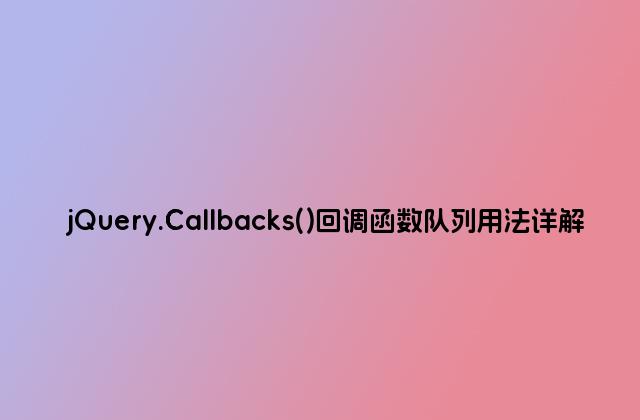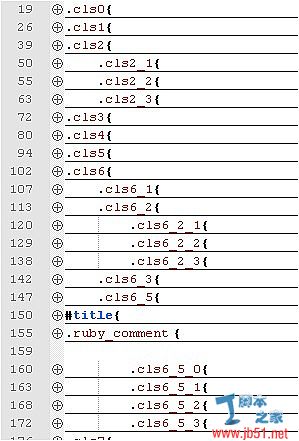
本文实例讲述了jQuery.Callbacks()回调函数队列用法。分享给大家供大家参考,具体如下:
1、jQuery.Callbacks
The jQuery.Callbacks() function, introduced in version 1.7, returns a multi-purpose object that provides a powerful way to manage callback lists. It supports adding, removing, firing, and disabling callbacks.
The $.Callbacks() function is internally used to provide the base functionality behind the jQuery $.ajax() and $.Deferred() components. It can be used as a similar base to define functionality for new components.
接下来,我们分别看下四个标准的控制标志。
1.1 once
创建的 callbacks 对象只允许被 fireWith() 一次 [注意:方法fire() 是 fireWith() 的外观模式]。
var callbacks = $.Callbacks("once");
callbacks.add(function(){console.log("f1");});
callbacks.fire(); //输出 "f1"
callbacks.fire(); //什么也不发生,在源码中已经禁用了 list.disable()
1.2 memory
在调用 add() 方法时,如果这时 callbacks队列 满足 fired && firing = false(真执行完毕) && memory(需要在构造函数指定),那么add() 进去的回调函数会立即执行,而这个 add 进去的回调函数调用时的参数存储在 memory 变量中。memory 变量用于存储最后一次调用 callbacks.fireWith(...) 时所使用的参数 [context, arguments]。
If the Callbacks object is created with the "memory" flag as its argument, additional functions may be added and fired after the callback list is locked.
$(function($){
var callbacks = $.Callbacks("memory");
callbacks.add(function(){console.log("f1");});
callbacks.fire(); //输出 "f1",这时函数列表已经执行完毕!
callbacks.add(function(){console.log("f2");}); //memory作用在这里,没有fire,一样有结果: f2
callbacks.fire(); //重新触发一次,输出 f1 f2。 firingStart = 0
//与once一起使用
callbacks = $.Callbacks("once memory");
callbacks.add(function(){console.log("f3");});
callbacks.fire(); //输出 "f3",这时函数列表已经执行完毕!
callbacks.add(function(){console.log("f4");}); //没有fire,一样有结果: f4
callbacks.fire(); //由于为"once",这里将什么也不执行
});
1.3 unique
回调函数列表中的函数是否可以重复,该特性与 add() 方法有关,可以避免在回调函数列表中加入多个相同回调函数。
var f1 = function(){console.log("f1");};
var callbacks = $.Callbacks();
callbacks.add(f1);
callbacks.add(f1);
callbacks.fire(); //输出 f1 f1
//传递参数 "unique"
callbacks = $.Callbacks("unique");
callbacks.add(f1); //有效
callbacks.add(f1); //添加不进去
callbacks.fire(); //输出: f1
1.4 stopOnFalse
默认情况下,当执行 fireWith() 方法时,整个回调函数列表中的所有函数都会顺序执行,但如果设置了stopOnFalse,那么当某个函数返回false时,后边的函数将不再执行。即使设置了memory,再次添加的函数也不会执行了,即一旦某个函数返回 false 的情况下,会禁用 memory 功能。但如果没设置”once”,再次调用fire可以重新触发该callbacks。
var f1 = function(){console.log("f1"); return false}; //注意 return false;
var f2 = function(){console.log("f2");};
var callbacks = $.Callbacks();
callbacks.add(f1);
callbacks.add(f2);
callbacks.fire(); //输出 f1 f2
callbacks = $.Callbacks("memory stopOnFalse");
callbacks.add(f1);
callbacks.add(f2);
callbacks.fire(); //只输出 f1
callbacks.add(function(){console.log("f3");}); //不会输出,memory已经失去作用了
callbacks.fire(); //重新触发,输出f1
2. memory 回调队列
var i = 0;
var inc = function (s){
i++;
alert(i +"$" + s);
};
var callbacks = $.Callbacks('memory');
callbacks.add(function iteral() {
callbacks.add(inc);
if (i <= 1) {
callbacks.fire(i);
}
});
callbacks.fire(i);
callbacks.add(inc);
/*
list = [];
list = [it];
--->fire(0), i=0
1、list = [it, inc]
2、push(fire(0))
3、i++ [inc(0)] (i=1)
shift()--->fire(0), i=1
1、list = [it, inc, inc];
2、push(fire(1)),
3、i++ [inc(0)]
4、i++ [inc(0)] (i=3)
shift()--->fire(1),i=3
1、list = [it, inc, inc, inc];
2、i++ [inc(1)]
3、i++ [inc(1)]
4、i++ [inc(1)] (i=6)
--->add(inc), i=6, memory=[this,1]
1、i++ [inc(1)] (i=7)
*/
3、 jQuery.CallBacks 源码
说明:为了便于理解,修改了部分源码,减少了一些功能~~~
jQuery.Callbacks = function (options) {
// string --> object 改进建议:将未配置的参数缺省为false,而不是undefined。便于程序阅读和控制.
options = optionsCache[options] || createOptions(options);
var firing,
memory, //Last fire value [context, args] (for memory lists)
fired,
firingLength,
firingIndex,
firingStart,
list = [],
stack = options.once === true ? false : [], // Stack of fire calls for repeatable lists
fire = function (data) { // data --> [context, args]
memory = !!options.memory && data; // false OR [context, arguments]
fired = true;
firingIndex = firingStart || 0;
firingStart = 0;
firingLength = list.length;
firing = true;
// 这里 list 放在条件判断中是因为执行回调函数可能会改变 list 的状态,比如 this.disable()。
for ( ; list && firingIndex < firingLength; firingIndex++) {
if (list[firingIndex].apply(data[0], data[1]) === false && options.stopOnFalse === true) {
memory = false; // 禁止 memory 功能,这样调用 add() 增加新回调函数不会立即自动调用
break;
}
}
firing = false;
if (list) {
if (stack) {
//进入条件: fired && firing === false && stack, 实现递归调用
if (stack.length) {
fire(stack.shift()); // [[context1, arguments1], [context2, arguments2]]
}
} else if (memory) {
// 进入条件: fired && firing === false && stack === undefined && 有memory字段(memory变量只能通过fire()函数修改)
// 这里的 list = [],主要是用于性能优化,以防该对象长时间不执行,占用系统内存
list = [];
} else {
// 进入条件: fired && firing === false && stack === undefined && 没有memory字段, 说明必要继续保留的必要
self.disable();
}
}
},
self = {
add: function() {
if (list) { //几乎所有API都应该绑定这个条件,因为我们需要处理队列
var originLength = list.length;
jQuery.each(arguments, function( _, arg) {
if (jQuery.type(arg) === "function") {
// (!(options.unique && self.has(arg))) unique字段的作用
if (!options.unique || !self.has(arg)) {
list.push(arg);
}
}
});
if (firing === true) {
// 进入条件: 说明正在执行回调函数队列中,而当前执行的这个回调函数激活了add()函数,及时维护循环边界
firingLength = list.length;
} else if (memory) {
// 进入条件: memory && fired && firing === false, 说明之前的 fire() 行为已经完全结束
firingStart = originLength;
fire(memory);
}
}
return this;
},
remove: function() {
if (list) {
jQuery.each(arguments, function( _, arg) {
var lastIndex;
while ((lastIndex = jQuery.inArray(arg, list, lastIndex)) >= 0) {
list.splice(lastIndex, 1);
if (firing === true) { // 及时更新边界条件,实现智能处理
if (lastIndex <= firingLength) {
firingLength--;
}
if (lastIndex <= firingIndex) {
firingIndex--;
}
}
}
});
}
return this;
},
has: function (func) { //这个API有两个功能,根据单一职责角度来说,应该增加一个 isNotEmpty() 接口(非空)
return func ? jQuery.inArray(func, list) > -1 : !!(list && list.length);
},
empty: function() {
list = [];
return this;
},
disable: function() { // 彻底禁用该对象, stack禁用, memory禁用
list = stack = memory = undefined;
return this;
},
disabled: function() {
return !list;
},
lock: function() {
stack = undefined;
// 如果memory没有存储调用状态,直接禁用这个对象(可能是从未调用就被锁定,或者没有memory字段)
if (!memory) {
self.disable();
}
return this;
},
locked: function() {
return !stack;
},
fireWith: function (context, args) {
args = args || [];
var data = [context, args];
if (list && (fired === false || stack) ) {
if (firing) {
// 进入条件: firing === true && stack 说明当前正在执行回调函数队列
stack.push(data); // stack其实是一个队列结构,这里用 stack 有些混淆
} else {
// 进入条件一: firing === false && fired === false 说明从来没有 fire()过
// 进入条件二: firing === false && fired === true && stack = [] 说明至少调用过一次,而且当前允许多次调用,可以通过lock()锁定
fire(args);
}
}
return this;
},
fire: function() {
self.fireWith(this, arguments);
return this;
},
fired: function() {
return !!fired;
}
};
return self;
};
4、胡思乱想
jQuery.Callbacks() 方法的核心是 fire() 方法,将该 fire() 方法被封装在函数中不可直接访问,因此像 memory、firing、fired 这些状态对于外部上下文来说是不可更改的。
还有需要注意的是,如果回调函数中使用了 this 对象,可以直接用这个 this 来访问self对象的公有API。当然,也可以用 fireWith() 自己指定 this 的引用对象。
jQuery.Callbacks()的核心思想是 Pub/Sub 模式,建立了程序间的松散耦合和高效通信。
更多关于jQuery相关内容感兴趣的读者可查看本站专题:《jQuery常用插件及用法总结》、《jquery中Ajax用法总结》、《jQuery表格(table)操作技巧汇总》、《jQuery拖拽特效与技巧总结》、《jQuery扩展技巧总结》、《jQuery常见经典特效汇总》、《jQuery动画与特效用法总结》及《jquery选择器用法总结》
希望本文所述对大家jQuery程序设计有所帮助。






